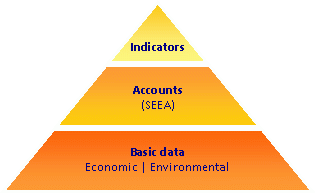- Repetto, R., Magrath, W., Wells, M., Beer, C. and F. Rossini (1989) Wasting Assets: Natural Resources in the National Income Accounts. Washington, DC: World Resources Institute.
Environmental-economic accounts
Introduction
23.210 This section describes the notion of environmental-economic accounts and the underpinnings of the environmental-economic accounts produced by the ABS. Those accounts follow the recommendations of the United Nations' System of Environmental-Economic Accounting (SEEA). The SEEA is an international statistical standard that had its genesis as a satellite system of the SNA. As a result, the SEEA utilises concepts, structures and methods that are largely consistent with those used in the SNA, allowing the SEEA to integrate environmental and economic information within a single framework.
23.211 Over the past 50 years, macroeconomic policy has largely been based on information flowing from the SNA framework and the aggregates it produces. However, gross domestic product and national income fail to capture many vital aspects of national wealth and well-being, such as changes in quality of health, extent of education, social connection, political voice, unpaid household work, and changes in quality and quantity of natural resources. Further, GDP actually includes ''defensive expenditures'' such as spending on household security, health and environmental protection. This is because the SNA measures activity within ''the market''.
23.212 It is well understood that much of what maintains and enhances well-being occurs outside the market. For example, environmental goods and services are considered 'non-market' within the SNA, and well within the production boundary. They are implicitly superabundant, free inputs to production. As a result, they are used as inputs to production, but not charged as costs of production; in effect:
23.213 A country could exhaust its mineral resources, cut down its forests, erode its soil, pollute its aquifers, and hunt its wildlife to extinction, but measured income would not be affected as these assets disappeared.¹¹⁷
23.214 A key limitation of the economic information system is that it cannot answer some of the higher order questions policymakers (and society) are asking. In particular, it does not appropriately describe the relationship between the environment and economy.
23.215 Therefore, a comprehensive analysis of environmental issues, and the policy responses to deal with these, must be informed by socio-economic information about drivers, pressures, impacts and responses. This information should be integrated with the associated bio-physical information so that relationships and linkages can be properly understood.
23.216 Environmental-economic accounts provide a conceptual framework for integrating the environmental and economic information systems. Similarly, organising environmental and economic information into an accounting framework has the capacity to improve basic statistics, and allows for the calculation of indicators which are precisely defined, consistent and interlinked, as illustrated in the figure below:
Figure 23.1 The information pyramid
Image
